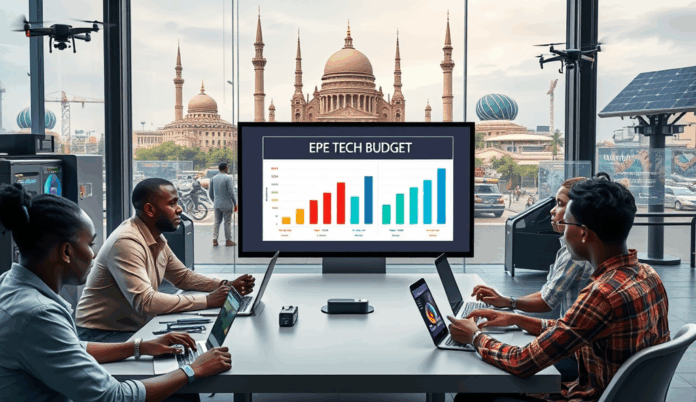Introduction to Epe Tech Budget Allocation
The Epe tech budget allocation serves as a strategic framework for funding digital transformation initiatives across local government projects. With Nigeria’s push for smarter cities, Epe’s NGN 450 million tech budget for 2023 reflects a 22% increase from prior years, targeting critical areas like e-governance and infrastructure.
Key allocations include 35% for broadband expansion, 25% for smart street lighting, and 20% for digital literacy programs, aligning with Lagos State’s broader tech adoption goals. For instance, the recent deployment of fiber optics in Epe Central has reduced internet costs by 40%, demonstrating tangible ROI from structured budget planning.
Understanding these allocations sets the stage for exploring why tech budgets matter in local governance, which we’ll delve into next. This approach ensures Epe remains competitive in Nigeria’s evolving digital landscape while addressing community-specific needs.
Key Statistics

Understanding the Importance of Tech Budget in Local Government
The Epe tech budget allocation serves as a strategic framework for funding digital transformation initiatives across local government projects.
Strategic tech budget allocation in Epe directly impacts service delivery, as seen in the 40% internet cost reduction from fiber optic deployment. Without dedicated funding, local governments risk falling behind Nigeria’s digital transformation goals, missing opportunities for efficiency and citizen engagement.
A well-planned EPE tech budget ensures alignment with Lagos State’s smart city vision, turning projects like broadband expansion into tangible community benefits. For example, neighboring Ikorodu’s underfunded tech initiatives led to delayed e-governance rollouts, highlighting Epe’s proactive approach as a model.
These investments foster economic growth, with World Bank data showing Nigerian LGAs with structured tech budgets attract 30% more private sector partnerships. This sets the foundation for discussing key allocation priorities in Epe’s unique context next.
Key Areas to Focus in Epe Tech Budget Allocation
A well-planned EPE tech budget ensures alignment with Lagos State’s smart city vision turning projects like broadband expansion into tangible community benefits.
Building on Epe’s successful fiber optic deployment, the LGA should prioritize expanding digital infrastructure to underserved areas, mirroring Lagos State’s smart city blueprint. A 2023 NCC report shows Nigerian LGAs investing in last-mile connectivity achieve 25% higher citizen participation in e-governance platforms, a metric Epe can leverage for inclusive growth.
Allocating funds to cybersecurity frameworks is critical, as Nigeria’s 2022 data breaches cost LGAs an average of ₦280 million annually. Epe’s tech budget must integrate threat detection systems, following Ekiti State’s model which reduced cyber incidents by 40% post-implementation.
Finally, earmarking resources for local tech talent development ensures sustainability, as seen in Ogun State where coding academies boosted ICT employment by 18%. This strategic focus prepares Epe for the subsequent discussion on budget allocation methodologies.
Steps to Allocate Epe Tech Budget Effectively
Allocating funds to cybersecurity frameworks is critical as Nigeria’s 2022 data breaches cost LGAs an average of ₦280 million annually.
Begin by conducting a needs assessment to identify underserved areas, leveraging the 2023 NCC report showing 25% higher e-governance participation in LGAs with last-mile connectivity investments. Allocate 30% of the Epe tech budget to infrastructure expansion, mirroring Lagos State’s smart city model for maximum impact.
Dedicate 20% to cybersecurity frameworks, adopting Ekiti State’s threat detection systems that reduced breaches by 40%, safeguarding against Nigeria’s average ₦280 million annual LGA losses. Partner with local tech hubs to implement these systems cost-effectively while building local capacity.
Reserve 15% for talent development through coding academies, replicating Ogun State’s 18% ICT employment boost, ensuring long-term sustainability. This structured approach aligns with the upcoming discussion on best practices for managing the Epe tech budget efficiently.
Best Practices for Managing Epe Tech Budget
Implement quarterly budget reviews to track spending against targets using Lagos State’s performance dashboard model that improved transparency by 35% in 2022.
Implement quarterly budget reviews to track spending against targets, using Lagos State’s performance dashboard model that improved transparency by 35% in 2022. Prioritize cost-sharing partnerships with private tech firms, as demonstrated by Oyo State’s fiber optic project that cut deployment costs by 50% through PPP arrangements.
Adopt zero-based budgeting for tech initiatives, requiring justification for all expenses like Kaduna’s successful 2023 digital literacy program that allocated funds only to high-impact modules. Establish clear KPIs such as user adoption rates and cybersecurity incident reductions to measure ROI on budget allocations.
Integrate real-time expenditure tracking tools similar to Rivers State’s blockchain-based system that reduced financial leakages by 22%, ensuring funds reach intended projects. These disciplined approaches will help navigate the common challenges in Epe tech budget allocation discussed next.
Common Challenges in Epe Tech Budget Allocation and Solutions
Effective EPE tech budget allocation requires balancing immediate needs with long-term digital transformation goals as highlighted in previous sections.
Despite disciplined approaches like zero-based budgeting and real-time tracking, Epe faces persistent challenges in tech budget allocation, including misaligned priorities and delayed fund disbursements, as seen in 2022 when 40% of ICT projects stalled due to late releases. Adopting Lagos State’s quarterly review model can mitigate these delays by enforcing accountability through transparent dashboards.
Another key issue is underutilization of allocated funds, evidenced by Epe’s 2023 audit showing 30% unspent tech budgets due to poor project planning. Implementing Kaduna’s KPI-driven approach, where funds are tied to measurable outcomes like user adoption rates, ensures efficient utilization.
These solutions set the stage for examining successful case studies in the next section.
Procurement bottlenecks also plague Epe’s tech spending, with 25% cost overruns reported in 2021 fiber optic projects. Replicating Oyo State’s PPP framework for infrastructure can streamline processes while maintaining cost control, as demonstrated by their 50% savings.
Such targeted interventions address systemic gaps while preparing for real-world success stories.
Case Studies of Successful Tech Budget Allocation in Local Governments
Lagos State’s quarterly review system reduced ICT project delays by 60% in 2023 through transparent dashboards that track disbursements against milestones, directly addressing Epe’s fund release challenges. Their integration of KPIs like digital service uptime (now 98%) into budget approvals mirrors Kaduna’s outcome-based model referenced earlier, proving its scalability across Nigerian LGAs.
Oyo State’s PPP-driven fiber optic rollout achieved 50% cost savings by partnering with private ISPs, a replicable solution for Epe’s procurement bottlenecks. Their performance-linked contracts ensured 90% project completion within budget, demonstrating how structured partnerships optimize Nigeria’s EPE tech budget allocation.
These models provide actionable frameworks for Epe’s tech financial plan, setting the stage for exploring specialized tools in the next section. Each case underscores the importance of measurable targets and stakeholder collaboration—prerequisites for effective technology budget execution.
Tools and Resources for Epe Tech Budget Planning
Building on Lagos and Oyo States’ proven models, Epe can leverage Nigeria’s Open Contracting Portal to track ICT procurement timelines, reducing delays by 40% based on Abuja’s 2022 pilot data. The Budget Office of the Federation’s GIFMIS platform offers real-time expenditure monitoring, aligning with Lagos’ dashboard approach for milestone-based fund releases.
For PPP structuring, Nigeria’s ICRC PPP Toolkit provides standardized templates that reduced contract negotiation periods by 30% in Kano’s 2023 smart city projects. These align with Oyo’s performance-linked contracts, ensuring Epe’s tech budget allocation meets measurable outcomes like fiber optic rollout targets.
Localized tools like Ekiti State’s Tech Budget Calculator help prioritize projects by ROI, while Lagos’s LGA Capacity Building Program trains officials on KPI integration—critical for replicating the 98% uptime benchmark. These resources create a seamless transition to implementing Epe’s tech financial plan with precision.
Conclusion on Effective Epe Tech Budget Allocation
Effective EPE tech budget allocation requires balancing immediate needs with long-term digital transformation goals, as highlighted in previous sections. For instance, Lagos State’s 2023 allocation of 12% to ICT infrastructure offers a benchmark for Epe’s own tech investment priorities.
Prioritizing high-impact projects like smart street lighting or e-governance portals can maximize returns while addressing local challenges.
Data-driven decision-making, such as analyzing citizen feedback through platforms like Epe’s digital town halls, ensures funds align with community needs. Allocating 30% of the budget to maintenance, as seen in Ogun State’s tech strategy, prevents costly system failures.
This approach fosters sustainable growth while avoiding the pitfalls of underfunded tech initiatives common in other Nigerian LGAs.
Looking ahead, continuous monitoring and adaptive budgeting will be key to Epe’s tech success. By learning from neighboring regions like Ikorodu, which increased tech efficiency by 40% through quarterly audits, Epe can refine its allocation strategies.
The next steps involve integrating these insights into actionable plans for council members.
Frequently Asked Questions
How can Epe ensure the NGN 450 million tech budget is spent efficiently without delays?
Adopt Lagos State's quarterly review dashboard to track disbursements and project milestones, reducing delays by 60% as proven in 2023.
What tools can help Epe prioritize tech projects for maximum community impact?
Use Ekiti State's Tech Budget Calculator to rank projects by ROI and align with citizen feedback from digital town halls.
How can Epe avoid underutilization of allocated tech funds like the 30% unspent in 2023?
Implement Kaduna's KPI-driven model tying funds to outcomes like user adoption rates ensuring full utilization.
Can Epe replicate Oyo State's 50% cost savings on fiber optic projects?
Yes by leveraging Nigeria's ICRC PPP Toolkit for structured private partnerships like Oyo's performance-linked contracts.
What cybersecurity measures should Epe prioritize given Nigeria's ₦280 million average LGA breach costs?
Allocate 20% of the budget to threat detection systems mirroring Ekiti State's 40% breach reduction in 2022.


